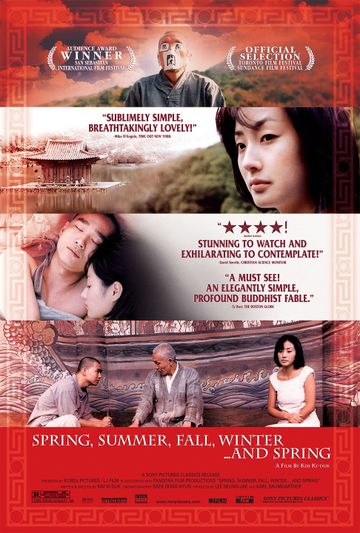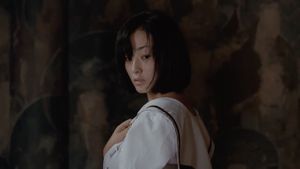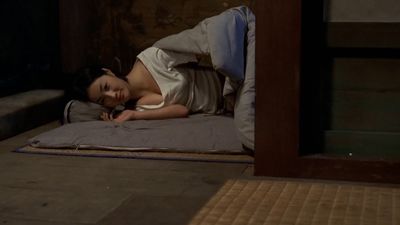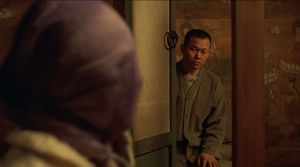봄 여름 가을 겨울... 그리고 봄
| Spring, Summer, Fall, Winter... and Spring | |
| Title (English) | Spring, Summer, Fall, Winter... and Spring |
|---|---|
| Title (Korean) | 봄, 여른, 가을, 겨을... 그리고 봄 |
| Directed by | 김기덕 (Kim Ki-duk) |
| Written by | 김기덕 (Kim Ki-duk) |
| Running time | 1 hour 45 minutes |
| Country | South Korea |
| Language | Korean |
목차
Plot
The film follows the story of a young monk with his Master living in an isolated floating monastery and shows the different stages of his life as told through five seasons
Spring
In Spring, he learns about respecting the living force of nature. And he also learns an important lesson that will echo throughout the film.
Summer
In Summer, he discovers love, lust and their pitfalls.
Fall
In Fall, he is forced to take responsibility for his actions- murdering his wife.
Winter
In Winter, arguably the harshest season; the apprentice becomes the master and he has to overcome both the mental and physical obstacles to take over the position that his master left.
... and Spring
And in the following Spring, he is now the master of the monastery, with a young apprentice who turns out to be as mischievous as him.
Cast
- Oh Yeongsu as the Old Monk/Master
- Kim Ki-duk as the Adult Monk
- Kim Youngmin as the Young Adult Monk
- Seo Jaekyung as the Teenage Monk
- Jong-ho Kim as the Boy Monk
- Ha Yeojin as the Girl
- Kim Jeong-yeong as the Girl's Mother
Release and Reception
Awards and Nominations
| Year | Award | Category | Nominee | Result |
|---|---|---|---|---|
| 2003 | Locarno International Film Festival | C.I.C.A.E. Award | Kim Ki-duk | Won |
| Don Quixote Award | Kim Ki-duk | Won | ||
| Netpac Award | Kim Ki-duk | Won | ||
| Youth Jury Award | Kim Ki-duk | Won | ||
| Golden Leopard | Kim Ki-duk | Nominated | ||
| Blue Dragon Awards | Best Film | Won | ||
| San Sebastián International Film Festival | Audience Award | Kim Ki-duk | Won | |
| European Film Awards | Screen International Award | Kim Ki-duk | Nominated | |
| Faro Island Film Festival | Golden Train Award | Kim Ki-duk (Jury Prize) | Won | |
| Kim Ki-duk (Best Film) | Nominated | |||
| 2004 | Bangkok International Film Festival | Golden Kinnaree Award | Kim Ki-duk/Best Film | Nominated |
| Camerimage | Golden Frog | Bae Dong-hyeon | Won | |
| Grand Bell Awards, South Korea | Grand Bell Award | Best Film | Won | |
| Las Palmas Film Festival | Golden Lady Harimaguada | Kim Ki-duk | Won | |
| Pacific Meridian International Film Festival of Asia Pacific Countries | Grand Prix | Kim Ki-duk | Won | |
| Russian Guild of Film Critics | Golden Aries/Best Foreign Film | Kim Ki-duk | Won | |
| Satellite Awards | Golden Satellite Award | Best Motion Picture, Foreign Language | Nominated | |
| 2005 | Argentinean Film Critics Association Awards | Silver Condor/Best Foreign Film, Not in the Spanish Language (Mejor Película Extranjera en Idioma no Español) | Kim Ki-duk | Won |
| Association of Polish Filmmakers Critics Awards | Honorable Mention/Best Foreign film | Kim Ki-duk | Won | |
| Chlotrudis Awards | Best Movie | Kim Ki-duk | Won | |
| Best Cinematography | Baek Dong-hyun | Won | ||
| Italian Online Movie Awards (IOMA) | Best Cinematography (Miglior fotografia) | Baek Dong-hyun | Nominated | |
| 2006 | Bodil Awards | Best Non-American Film (Bedste ikke-amerikanske film) | Kim Ki-duk | Nominated |
| Danish Film Awards (Robert) | Best Non-American Film (Årets ikke-amerikanske film) | Kim Ki-duk | Nominated | |
| Sofia International Film Festival | Burgas Municipality Award 'Silver Sea-Gull' | Kim Ki-duk | Won |
Academic Analysis
Buddhism
Director Kim Ki-duk emphasized that he deliberately did not research about Buddhism nor consult any Buddhist experts prior to making the film because he did not intend for it to be received as a religious text. (Chung, 2012, 108) However, given the nature of the storyline, there is a tendency to discuss the film from a religious point of view. It is also significant to note that a significant amount of research focuses on the Buddhist aspects of the film.
The Role of Women in the Film
In comparison to Kim’s previous works, this film is far less graphic and subtle, focusing on a tale of solitary Buddhist life with little to none dialogue. More importantly, does not display controversial scenes regarding sexual violence against women. Although it can be argued that Kim’s Spring, Summer, Autumn, Winter… and Spring is not a Buddhist film is its core, the use of male Buddhist monks and their monastic life as a means to deliver a “universal” message open the floor for criticism in terms of how women are perceived in the religion. However, Jason Bartashius (2017, 2) argues that the Buddhist culture is inherently patriarchal and consequently dictate the manner in which women are portrayed in the movie: as temptresses and symbols of suffering. In this sense, this work is no different from Kim’s previous films in its treatment of women.
Existing literature on Buddhist texts and cultures provide evidence that there are quite vague and simultaneously conflicting ways that such religious texts portray women. Analysis on Buddhist literature, specifically on Therigatha- an anthology of poems on the early Buddhist women, by Rita Gross (1993, 30) points out that from its inception, Buddhists support two slightly contradicting beliefs: that there are issues and concerns with women and that women also have the potential to achieve enlightenment. In the same vein, Sponberg (1992) claims that early religious texts were quite ambiguous on gender offering both positive and negative evaluations of women. In his analysis, he scrutinizes four specific categories of attitudes towards women that highlight the textual basis that different Buddhist institutions utilize to either include or ostracize women. One category is called ascetic misogyny, which, given its name, is considered to have a more negative view towards women. This category maintains a belief that women are not capable of achieving enlightenment and that they are “a threat to male celibacy”.
A. The Temptress
The highlight of the Summer episode is undoubtedly the teenage monk’s sexual awakening, where his thirst for sexual pleasure is aroused by an ailing young woman who arrives at the temple monastery to seek healing. Subsequently, he inevitably gives into his desires and forms an attachment with the woman which is an obstacle to his path to enlightenment. Given that the movie is generally presented from the young monk’s perspective, it is unavoidable that the viewers will perceive the young woman as a temptress and a distraction from his spiritual goal rather than just a mere love interest.
Buddhism’s Four Noble Truths teaches that life is suffering, and that suffering comes from thirst and desire. This teaching was evident in the film, with the adult monk ultimately murdering his wife after leaving the monastery to pursue her. According to the Sri Lankan Buddhist monk Walpola Rahula, the Buddha defines thirst and enumerates its different types:
- "It is this “thirst” … which produces re-existence and re-becoming … and which is bound up with passionate greed … namely, (1) thirst for sense-pleasures … (2) thirst for existence and becoming … and (3) thirst for non-existence."*
With thirst as a hindrance to the path of enlightenment, the eradication of desire is important for monks and therefore remaining celibate is of utmost concern for them. Monastic codes in the Buddhist canon describe specific ways to remove desire, particularly by perceiving the body in itself as vile in order for one to detach himself from such physical and sexual desires. However, Sharon Suh (2015, 79) argues that in there is an inclination to think of “female bodies as dirty, loathsome, abhorrent, and by extension, material embodiments of the immoral” based on Buddhist canonical texts. Because of this, women are perceived to be representations of such desire and thirst that monks should eliminate [in order to achieve enlightenment].
Existing feminist literature on the film (Bartashius, 2017; Suh, 2015) argue that Buddhist literature not only views women lower than men, but more importantly, that women are characterized as evil. Sharon Suh (2015, 82) cites the tale of Sirima from the Dhammapada in the Theravada Pali Canon as an example. It tells the story of Sirima, a young former courtesan whose beauty arouses a young monk’s desire. He becomes so taken with her beauty that he seeks her out multiple times, finding her beautiful even when she fell quite ill. Knowing the situation, the Buddha decides to make a public display of her body after she dies (from her illness) as a way to provide a lesson in eliminating desire. Upon her death, the King was instructed by the Buddha to have Sirima’s body displayed in the cemetery. After three days, her body begins to bloat and decay with which the King announces that all should come to the cemetery to observe her body. The young monk rushes over to discover that her body is being sold for one thousand in cash, but no one is willing to buy her for any price. As the young monk meditates on her death, he realizes that the same woman who was the object of desire is now just a rotting corpse.
- “Now there is no one who will take her even for free. Her beauty has perished and decayed.” Saying, “Monks, look at this diseased body,” he spoke the following verse [Dhammapada 147]: “Look at this decorated image, an elevated mass of wounds. This diseased thing is highly fancied, (although) it’s neither permanent or stable.”
Although the young woman in the film did not intend to lure the young monk into breaking his vow of celibacy in the beginning through her actions, scenes succeeding their first sexual encounter evidently portray the young woman as a temptress. To cite some examples, there is a scene where she gestures to the young monk to come over to her side of the bed by lifting up her blanket to which he obliges, deliberately going over his master to get to her bed. And on her unknowingly last night in the temple, she leaves her room with a subtle but suggestive look towards the young monk which leads to their sexual encounter in the boat.
It is also important to note that it is only the woman and not sexuality in itself was portrayed as evil in the film. Suh (2015, 85) goes even further to argue that the film shows that “sexuality can be a profound teacher advancing the monk toward his spiritual awakening so long as he abandons the woman afterwards.” In the film, it can be seen that the Master does not explicitly condemn sexuality but actually suggests that it was cure to the young woman’s illness. However, similar to Sirima, whose deceased body was left to rot in public, the young woman is essentially abandoned by the young monk as well.
B. The Voiceless
In the film, it can be observed that women have no agency and ultimately serve their purpose to help push the patriarchal narrative forward. This applies to the two significant female characters in story, namely the young woman in Summer and the weeping mother in Winter. Bartashius (2017, 7) reiterates that both women’s associations with both the monk, in Summer and Winter respectively, emphasize the belief that the spiritual path to enlightenment is inherently a masculine struggle.
In the Summer episode, an ailing young woman arrives with her mother to seek healing. Right from the viewer’s first glimpse of this woman, her petite and frail body establishes weakness and her position as a damsel in distress. Given her purpose for coming to secluded floating monastery, she is essentially an outsider under the care of the Master and his disciple. Consequently, the woman’s actions are always in relation to the monk. This arrangement in itself is a subtle nod to ascetic misogyny in the manner that is displays how women are viewed lower than men. Furthermore, it is significant to mention that although the young woman attempted to show some resistance to the young monk’s advances, she ultimately allows him to drag her to the rocks, enabling him to fulfill his sexual desires. Ensuing her sexual relations with the young monk, she does not leave the monastery by her will, but rather she was ordered to leave by the Master, who explicitly mentions that the cure for her illness was sex.
One of the film’s characteristics is its minimal dialogue, which gives greater weight to every single sentence uttered. Particularly, most of the minimal dialogue is only spoken by the male characters; the Master and his disciple. In addition, it is also important to note that even the two policemen who arrive at the temple monastery in the Autumn episode are given more lines than the young woman (Summer) and mother (Winter), despite the women having arguably more significant roles. Apart from reactionary shrieks, the young woman in Summer only utters “Yes” in response to the Master’s question of whether or not she was already feeling well. On the other hand, it is only the crying mother’s sobs that can be heard from her in Winter.
Child, Adult, Elderly Monk as One Being
The Master's Reincarnation as a Snake
Imagery and the Narrative World
Nature
In an interview with Kim Ki-duk, he describes the first stages of the film as a search to answer this fundamental question: “What is man?”. And as can be seen from the film, the answer to this question can be observed through the narrative world the director has established. Kim says “Man is nature, and nature is signified by the four seasons, which echo the life of a human being from birth to death.” (Felperin, 2004, 33) This analogy was the expressed on the screen through distinct episodes in the young monk’s life, from childhood to manhood.
Focusing on the visual imagery of the film, it is evident that that nature is as important as the actors in the film from a visual perspective. A significant portion of the movie presents the audience with a multitude of wide shots of greenery, and elements such as the considerably imposing tree that is located beside the main gate of the temple and the water surrounding the temple. Through this, the audience is compelled to feel the weight of nature’s significance given how much space it occupies in a frame.
Nature: The Lake
Existing literature by Green and Mun (2019) examines this structural element from a Buddhist perspective and construes the lake as a representation of the young monk’s mind, with the front gate serving as the “borderline of the lake”, hence the frontier of the young monk’s mind. They point out that the young monk’s misdeeds in Spring, Summer and Fall all occurred outside the realm of his control— outside of the lake. For instance, the child committing animal torture, the adolescent young monk engaging in his first sexual encounter and subsequently, the murder of his wife all took place beyond the borders of the lake. Because of this, they claim that all of these events occurred given his lack of control and due to his yearning for being “oriented outwardly as opposed to inwardly”. Granted, this desire goes against the nature of enlightenment and holding an inward orientation. Consequently, the guilt that the young monk has accumulated from committing such misdeeds shifts into his mind (in this case, the lake).
Although a considerably meaningful interpretation, it fails to explain how the young monk’s succeeding sexual encounters transpire within the lake (or the realm of his mind). Following the logic their argument has provided, it can be implied that engaging in sexual relations is a manifestation of the inability to control one’s minds and desires. However, one instance happens one night at the monastery itself while their final encounter occurs on the boat floating in the lake itself. If these events occurred within the realm of the young monk’s mind, certainly the decision to involve himself in the succeeding sexual relations was made with a conscious mind. Given this, this interpretation leaves room for doubt and critique.
Apart from the Buddhist perspective, it is also important to decipher the meaning of the lake from a practical perspective. In the film, the lake is shown as a continuously flowing element, and one that brings the characters from one point to the other. There are a number of relevant sequence of shots that emphasize this quality, with one shot from the inside the temple looking outward showing the change of scenery, indicating the passage of time. Accordingly, the lake can be seen as a symbol of time and change given that on a basic level, the water from the lake flows out of the lake to larger bodies of water. Parallel to this, the young monk, in Autumn, makes the decision to leave the monastic life in order to pursue the young woman. This in turn marks a shift in the character’s life, which can be considered to be similar to water flowing out of the late. Additionally, it is interesting to note that in the Winter episode, the imagery of the frozen lake seems to imply that time has come to a momentary standstill following the Master’s death in Autumn.
Nature: Mountains
Structural Elements
It is said the integral structures such as the floating temple and the gate were purposely built for the film. This extends to the Buddhist images on these structures, including the boat. (Green, Mun, 186) Given this, there is good reason to consider that the narrative world of the film plays an important role in deciphering the characters and the story itself. Examining these structural elements will be useful in the attempt to gain a deeper understanding of the seemingly simple yet sophisticated story of life and repetition. The following sections will discuss interpretations of specific structural elements:
Structural Elements: Floating Temple
Structural Elements: Wall-less Doors
The concept of wall-less doors is arguably one of the things that left the greatest impression in the film. For most of the story, the characters acknowledge the two doors for each “room” as the entry and exit points, consciously following the unwritten rule of passing through the door to arrive at the center room and subsequently leave the monastery. There is only one instance, however, where this rule was violated; in the Summer episode, the young monk deliberately ignores the door as he realizes that opening the door would wake his Master, thereby passing through the space beside it in order to move to the young woman’s “room”. With this, doors in the film can be seen as a representation of the rules or norms that society has. Furthermore, it can be said that the young monk’s conscious ignorance of such rule is evident of his transgression and deviation from the norm.
Francisca Cho (2014, 116-7) offers a more profound take on this, arguing that the wall-less doors symbolize mental discipline and perception. The existence of these doors is constant reminder for the characters to be mindful, and therefore ignoring them shows unmindfulness and difficulty in maintaining one’s inner peace. Following this logic, the young monk’s deliberate ignorance of the door in the Summer episode not only shows his transgression, but how his mental discipline falters in the presence of women. This unmindfulness consequentially represents his “failure to maintain the clarity of one’s inner space”. However, the shift in the monk’s perception is evident in the Winter episode as he sits behind the door of his room, repeatedly opening and closing the door in order to catch a glimpse of the crying mother. In this scene, he now displays mental discipline as he mindfully glances at the mother.






